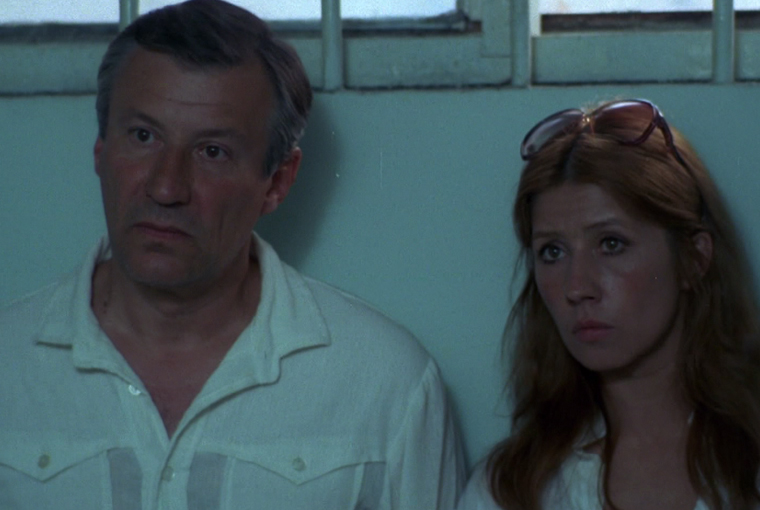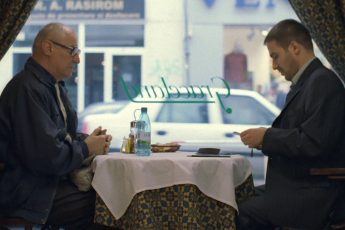Emtpy Judgments
Dan Piţa’s Sand Cliffs (Faleze de Nisip, 1983)
Vol. 1 (January 2011) by Moritz Pfeifer
An empty judgment (what contains no ground of any cognition, thus tautological judgments) is a judgment which contains no concept, which is wholly indistinct, when I explain obscurum per aeque obscurum.“
– Immanuel Kant, Lectures on Logic
Dan Piţa’s Sand Cliffs (Faleze de Nisip, 1983) tells the story of a young man (Gheorghe Vis) who is arrested for stealing invaluable belongings from a doctor (Victor Rebengiuc) during his vacation at the beach. The film begins when one of the doctor’s friends thinks he recognizes the thief a couple of days after the crime. Convinced that he is guilty, the doctor decides to turn him in. But despite of “the kid’s” possible innocence, the doctor’s anxiety to blame someone for the theft, turns into an absurd power struggle, revealing a system of justice where accusations already include judgment and punishment, even if the accusation turns out to be false. The young man is thus pronounced guilty, and he falsely admits his guilt after giving in to the humiliating methods of local police authorities whose readiness to defame and terrorize the inmate marks him with indelible psychological traces.
In this society condemnation does not happen on the basis of a legally pronounced verdict. It can happen prior to any verdict, when accusations serve as prefigured judgments and not as measures of truth. A similar judgment happens to Manny (Henry Fonda) in Hitchcock’s The Wrong Man, although it is his wife (Vera Miles) who accepts the punishment, suffering from feelings of guilt even after her husband is freed from the charges. It happens in numerous stories by Kafka, where people are being judged and tried without concrete facts, and the accused characters give up their innocence, often believing in their guilt with heroic abnegation. It happens in prison camps where guilt is proclaimed on the basis of somebody’s race, religion, or origin – concepts that are impossible to verify through measures of reasonable judgment.
Kant’s short definition of the “empty judgment” that appears in his Lectures on Logic, might help to understand the mechanism such judgments represent. In this passage, an empty judgment describes the incapacity to determine the truth of something, meaning that an empty judgment refuses to become true or false. This is exactly what happens in Sand Cliffs. The doctor is incapable of thinking of guilt as something that can be verified. His judgment denies “cognition”, as a process in which information is allowed to become known. His judgment is empty, not because it is based upon a false accusation, but because it does not apply to a truth enabling value. The doctor still believes in his judgment after it is known that “the kid” is not guilty, making the revision of its own application impossible. It is thus a judgment that is part of an obscure or imagined proposition.
The imaginative, or “truth-valueless” character of the doctor’s accusation can be seen very well in his various attempts to recapitulate the crime scene. In the first flash-back we do not see the face of the thief, but only his black hair, as well as the jeans and the black t-shirt he wore. But that information seems to suffice to provide the necessary truth for the judgment to hold. Later, as doubts start to appear over the guilt of the prisoner, the flashbacks become more and more detailed, up to the point where the doctor replaces the face of the real thief with that of the accused young man. In a sequence of alternate shots, the unidentified guilty thief vanishes behind the innocent one, putting the mental process of the doctor into visual form. In the final scene, these imaginative visions culminate. As if hallucinating, the doctor stumbles into the water trying to catch “the kid” in a desolate landscape. The scenery reflects the emptiness of his judgment made him keep chasing the thief although there was nothing there from the start.
When Kant argues that empty judgments are tautological, he describes propositions that stay the same, meaning that they don’t give any insight into the relation between subject and predicate. “Guilt is guilty” is an empty judgment, so is “the thief thieves.” The doctor’s logic functions in that manner. He cannot separate subject and predicate, they always return to the same place. If he could say, “the thief is guilty”, then he would use a concept that would allow a legitimate judgment, and a distinction between subject and predicate, which would provide some basis to determine the truth of information. That the people with the power to judge lack that basis can also be seen in the police officer, who paradoxically recommends that it is not important whether the young man stole or not, it is important to tell the truth, thus admitting that truth is not a question of information.
But to call such a judgment empty is confusing because it would understate that there is actually something happening. “The kid” not only looses his job, which excludes him from social life, but he also suffers from the after-effects of the humiliations. There is one scene where these humiliations, like the visions of his adversery, become visible through flashbacks. Alternating with shots of “the kid’s” wood-working machines, an earlier scene reoccurs, in which he is helplessly digging for the stolen objects in a gesture that imitates the servile behavior of a dog. Knowing he will not find the loot, he nonetheless succumbs to the doctor’s will, accepting his theft as something that exists, that can be found. It wouldn’t seem wrong to say that “truth-absent” judgments replenish, because they tend to fill in what isn’t there.
We have seen that for the doctor, “the kid”, inhabits the predicate “guilty”, as the same time as the subject-position of “guilt”. This means that there is no subject that can become guilty because the subject is guilt, turning “the kid” into a nonexistent abstraction. Nonetheless such a subject-thwarting proposition is real, because the one who proposes it, the doctor, has the power to make sense of it, and turn the proposition into a fact. In Sand Cliffs, “guilt” turns into a concept, even if it works with the “non-conceptual” logic of tautological propositions.
Tautology can thus be understood as an interplay of truth and reality, in which reality is constituted through doubled truths. For instance, when the contradiction “innocent guilt” is true, and “guilt” is no longer self-explanatory, the tautology “guilty guilt” enforces consistency. So instead of accepting breaks or discontinuity, which are necessary parts of reality, modes of judgments turn into tautologies when they refuse to acknowledge substantial contradictions. Tautology thus enforces the reproduction of a proposition that has become untrue, and that can only stay true when there are no discontinuous concepts that could test, as Kant has it, their truth. It is only then that judgment can change or adapt. This turns tautological judgment into a process of denial, where un-tautological truths are ruled out.
But why does the young man come to represent theft and not some other proposition? For if he “steals”, he doesn’t steal objects. Most obviously he steals innocence. His seizure is thus composed of the moral judgment his judges fail to keep alive. It is this theft of judgment, of being able to tell the truth, that makes him guilty. The same guilt is at the core of The Wrong Man, where Manny’s culpability aggravates, the more innocent he appears to be. Neither Manny nor “the kid” drink or smoke: they are punctual, hard-working, and in love. Archetypically, they represent the “good man.” But it is the ability to judge their own moral position that turns them into plagiarizers of the system that judges them.
Thieves are all those who posses innocence when innocence no longer makes sense (in-no-sense). The doctor, who accuses the young man of theft, does not mean “one particular thief” he means “all thieves.” How can he speak of “one thief” if he hasn’t seen him? Even if it only were one, the doctor would still wish all thieves of innocence to confess (innocent guilt) so that they adapt to the common innocence (guilty innocence) of society. But “the kid”, as well as Rose in The Wrong Man tragically or heroically fail to adapt to this commonality. “The kid” knows that his innocence is real, that the innocence of commonality isn’t and that this truth cannot be corrected because it doesn’t have to be proven. But “the kid” still decides to compete with the doctor’s efforts to secure the innocence of commonality, fighting for his individual rights. In the end, he only partially wins, the prize being abuse and seclusion. But as his actions become more concrete and more particular, the nonsensical judgments begin to break apart. At the very end he kills the doctor and this action might explain: obscurium per proprium.




Leave a Comment